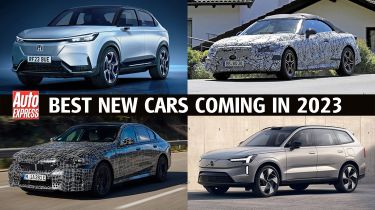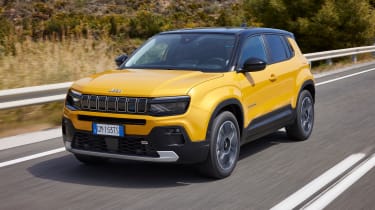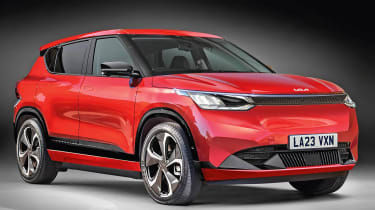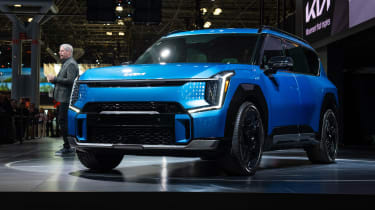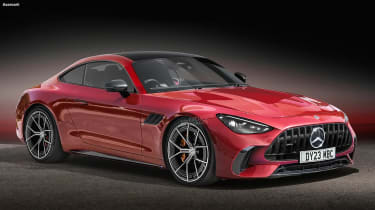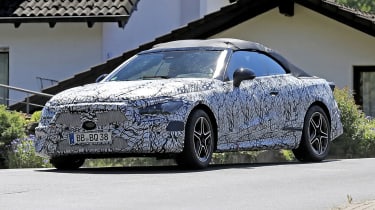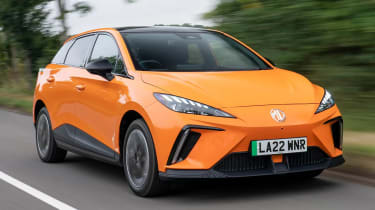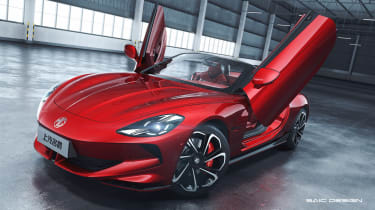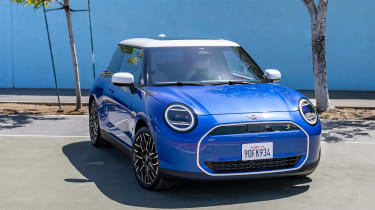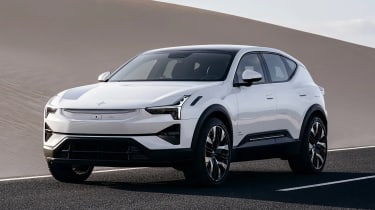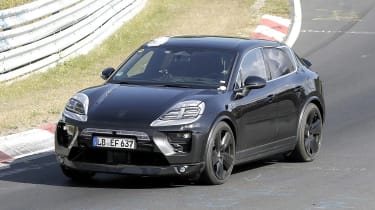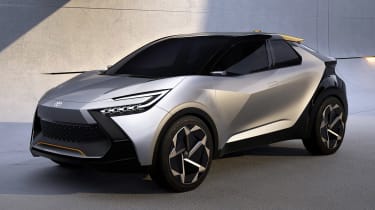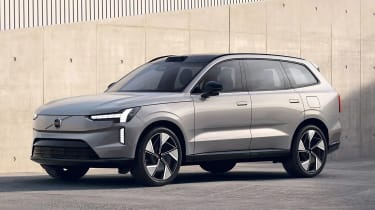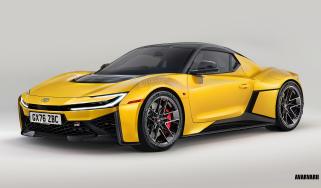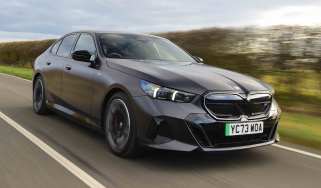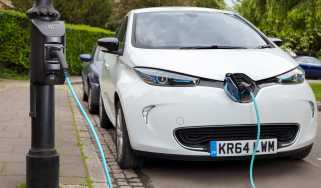Best new cars coming in 2023 - Jeep to Volvo
There are some big new models from the likes of Audi, BMW, Hyundai, Kia, Mercedes, MG and more on the way in 2023
Jeep Avenger
At last, Jeep has a car designed and engineered in Europe, for European customers – and the Avenger certainly has the potential to shake up the baby SUV market.
Based on an evolution of the e-CMP platform that also underpins the Vauxhall Mokka and Peugeot 2008, the Avenger is one of the most compact offerings in the class. But its reduced overhangs, designed to improve its approach and departure angles off road, also deliver better cabin space than in many rivals.
The car is being offered only as an EV in the UK. It features a 54kWh battery, and offers an official range of 248 miles, 100kW charging, and a single front-mounted motor producing 154bhp. A four-wheel-drive version is expected to follow later in 2023 or early in 2024, but Jeep claims that even the regular front-drive edition is capable off-road, with ground clearance to match that of its larger stablemate, the Renegade.
Pricing for Jeep’s first EV starts from £34,800, which undercuts its Vauxhall Mokka Electric sibling by over £4,000.
Read our review of the Jeep Avenger
Kia EV4
With the EV6, Kia hit the ground running with its first bespoke electric car, and the brand is aiming to build upon this success with a range of new models wearing the EV moniker. A fully-electric crossover - potentially called the EV4 - is set to join the lineup this year, based on the Hyundai-Kia Group’s E-GMP architecture. With a shorter wheelbase than the EV6, the EV4 will be closer in size to the Sportage SUV, and over 300 miles of range could be possible thanks to a 77.4kWh battery.
Dual-motor powertrains are expected to feature at the top of the range, although Kia is likely to offer a rear-wheel drive single motor variant for a lower cost. Given that the E-GMP platform uses an 800-volt electronic architecture and 350kW rapid charging capability, a 10 to 80 per cent charge could take less than 20 minutes.
Kia EV9
The launch of the EV6 in 2022 continued Kia’s transformation into a powerhouse in the all-electric market. And in the coming months, the firm will bolster its position further with the huge EV9 SUV.
The five metre-long creation will be comfortably the largest Kia ever sold in the UK – but the firm is confident that its proven electric motors and in-car tech carried over from the EV6 plus a seven-seat layout will give it an advantage over other practicality-focused EVs such as the Mercedes EQB. Its styling will be strongly influenced by a concept (pictured above) that was revealed in Los Angeles back in 2021, retaining the boxy profile but toning down some show-car elements, such as the digital side mirror cameras.
Expect entry-level EV9s to use the 77kWh battery pack from the EV6, but this could be enlarged to fill the longer wheelbase and deliver extended range on higher-end editions. There should be single and dual-motor versions too, while the 800V electrics that form the basis of Kia’s e-GMP platform should allow charging speeds in excess of 220kW.
Pricing is expected to start from around £65,000, and this will make the EV9 the most expensive Kia yet.
Mercedes-AMG GT
Performance brand AMG has already delivered the all-new SL roadster on a fresh platform. But later this year we’ll get to find out how the architecture works beneath a more focused sports car, the second generation of Mercedes-AMG GT.
We know the new model will be offered with a straight-six petrol engine in entry form and V8 power in higher-end editions, but recent spy shots have suggested that it may also be engineered to accept a plug-in hybrid powertrain.
Either way, expect the GT to be positioned directly as a rival for the Porsche 911, with a more aggressive profile than its predecessor and pronounced haunches over the rear wheels giving it an altogether more focused look than its open-topped SL stablemate.
In a change from the outgoing model, four-wheel drive is likely to feature across the line-up, and power outputs could range from around 450bhp to as much as 800bhp. Expect rear-wheel steering, active anti-roll bars and adaptive suspension to feature too, while inside, the cabin should get the same 11.9-inch touchscreen infotainment system as the SL, albeit with different graphics.
Mercedes CLE
A totally new badge will take its place in the Mercedes line-up in 2023 with the arrival of the CLE. The car, previewed in our exclusive image, will in effect replace both the C-Class and E-Class coupes and convertibles, giving Mercedes the chance to reduce the complexity of its product portfolio with a new purpose-made rival for the BMW 4 Series and Audi A5.
This four-seater will make use of the brand’s MRA2 architecture and will be offered with turbocharged four-cylinder petrol engines, although six-cylinder power would be compatible with the platform for high-power AMG applications. A four-door coupe version of the CLE is not expected.
MG4 AWD
One of the biggest hits of 2022 was the MG4 electric hatchback – and this year we should see the practical, value-focused EV add a high-performance variant.
Company sources have admitted that a faster version is on the way, with MG’s UK commercial chief Guy Pigounakis promising a “high-performance, twin-motor derivative”. It’s likely to be a European version of a model already revealed in China, which packs more than 440bhp from a pair of electric motors. That would make it the most powerful model ever sold by MG in the UK, and deliver a 0-62mph time of around four seconds.
It’ll cost more than the regular MG4, of course, but the company is likely to harness its Chinese manufacturing connections to undercut potential rivals such as the Cupra Born, as well as outgunning them.
MG Cyberster
Bulging order books and renewed interest from British consumers in the Chinese-owned MG badge mean the company is on a roll right now. The firm has ambitious plans to build on this success, and we have seen one of the brand’s boldest steps this year, with the debut of the Cyberster roadster.
The spiritual successor to the MG TF is a two-seat fully-electric convertible. The Cyberster’s powertrain is planned to be available rear or four-wheel drive, with the range-topper producing 536bhp.
The production model sports several concept-like features, including scissor doors and a steering yoke instead of a regular wheel, as MG tries to give its offering a hi-tech feel and make it stand apart from the likes of the Mazda MX-5 and BMW Z4.
MINI Countryman
There’s an all-new electric MINI Hatch in the pipeline, but the brand’s Countryman SUV remains a popular choice too, and the next generation is set to arrive later this year.
The new Countryman is based on a further evolution of the BMW Group’s UKL2 platform, as used on the recently launched BMW X1. Expect mild-hybrid versions to form the bulk of the range, starting with models using 1.5-litre petrol power, but there will also be a pure-electric edition, potentially featuring the same 64kWh battery and electric running gear as the iX1.
The Countryman will also grow in size, up from 4.3 metres to around 4.5 metres, delivering a boost in practicality and making space in the MINI line-up for an all-new five-door model called Aceman.
MINI Hatch
One of 2023’s biggest arrivals will be the new MINI. The all-electric version of the car will ride on a fresh platform developed specifically for the brand, and it’s expected to offer battery capacities from 40kWh to around 50kWh, and either 180bhp or about 215bhp delivered through the front-mounted motor.
The new MINI’s looks are a much cleaner evolution of the current model’s, with revised light designs. The cabin will feature a different take on the existing circular infotainment set-up, more akin to a ‘floating’ tablet in execution.
Polestar 3
Volvo’s sister brand is gaining confidence and it will be hoping for further gains when it introduces the 3 later this year. Unlike the 1 and 2, which were derived from projects started by Volvo, the 3 is a ground-up Polestar creation. It sits on the same chassis components as the new Volvo EX90, but has a swoopier profile and a different front-end look that’s said to be more in line with the planned family design.
Beneath it all there’s a 482bhp and 840Nm twin-motor set-up, enough for a 0-62mph time of five seconds. A Performance variant will deliver 510bhp and trim a few tenths of a second off that time.
The cabin features sustainable materials and the dashboard is dominated by a 14.9-inch, portrait-layout touchscreen system.
Porsche Macan EV
Having enjoyed sales success with the Taycan EV, 2023 will see the German premium brand branch out with its second pure-electric vehicle, the second-generation Macan. The keen-driving family SUV will switch to a new all-electric platform, called PPE, that it’s sharing with Audi’s Q6 e-tron.
However, Porsche’s engineers are confident that their chassis tweaks, including the firm’s first use of two-value dampers, torque vectoring and the most complex version yet of Porsche’s Active Suspension Management, will help to maintain the Macan’s position as one of the most rewarding SUVs to drive at any price.
We’re still waiting for full technical info, but expect a battery capacity of around 100kWh and recharge speeds that beat the Taycan’s maximum rate of 270kW. There will be multiple motor configurations, but the car should launch with a two-motor set-up producing around 600bhp and more than 1,000Nm of torque.
Toyota C-HR
The C-HR has been a smash hit for Toyota since it was introduced in 2016, and the firm will be hoping to build on this success with the second generation of the car, which is due in the second half of this year.
This concept pictured, called C-HR Prologue, was unveiled late in 2022, and is said to give a close preview of what we should expect from the new model. Its overall stance and many of the show car’s details will remain, so it’s safe to say that the new C-HR will maintain the original’s focus on dramatic styling, rather than all-out practicality.
Toyota hasn’t issued many technical details, but the next C-HR is likely to feature most of the fifth-generation hybrid systems that are making their debut in the latest Prius. The company has also confirmed a plug-in C-HR will sit alongside the regular hybrid edition. Given how efficient Toyota’s hybrid systems are when coupled with plug-in power, we’d expect a pure-electric range north of 40 miles, dropping the C-HR into an appealing Benefit-in-Kind band for company car users.
Volvo EX90
The world has been waiting a long time for a new Volvo flagship SUV – but the successor to the XC90 gets more than a fresh badge. The EX90 also crams in oodles of new technology and switches to a fresh platform that supports all-electric powertrains.
The car’s look is perhaps more evolutionary than expected; it’s clearly identifiable as a top-of-the-range Volvo SUV, with a new take on the ‘Thor’s hammer’ headlights and a typically bluff profile. The blanked-off grille is a clear pointer to the greener underpinnings, though.
The car is being launched with a choice of two-motor configurations, with either 402bhp or 510bhp. Even the more modest of the pair can sprint from 0-62mph in less than six seconds, but both are limited to 112mph as part of Volvo’s safety policy. Regardless of motor choice, the EX90 gets a 107kWh battery for around 360 miles of range, and there’s 250kW DC charging that can take the system from 10 to 80 per cent in half an hour.
These step changes don’t exactly come cheap; Volvo has already admitted that the EX90 will arrive in dealers carrying a price tag in excess of £100,000, putting the car squarely into Range Rover territory.
